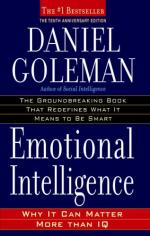
|
| Name: _________________________ | Period: ___________________ |
This test consists of 15 multiple choice questions and 5 short answer questions.
Multiple Choice Questions
1. According to researchers in “Part Three: Chapter 9, “Intimate Enemies,” girls learn what faster than boys, and therefore become more skilled at expressing and reading emotions?
(a) Language.
(b) Temperance.
(c) Anger.
(d) Exaggeration.
2. Author Daniel Goleman has been nominated for what prestigious award two times?
(a) The Nebula Award.
(b) The Pulitzer Prize.
(c) The Ambassador book Award.
(d) The National Book Award.
3. What psychologist tracked 200 couples identifying significant signs that predict which marriages will fail based on how they handle disagreements?
(a) Peter Sifneos.
(b) Thomas Hatch.
(c) John Gottman.
(d) Howard Gardner.
4. John Lochman is a psychologist at what university?
(a) Emory University.
(b) Rutgers University.
(c) Duke University.
(d) New York University.
5. As businesses rely more and more on teamwork in a global environment, the more prized employees will be the ones who demonstrate what?
(a) Emotional intelligence.
(b) Anger management.
(c) Verbal development.
(d) Somatic markers.
6. Where is neuroscientist Torsten Wiesel from?
(a) Greenland.
(b) Finland.
(c) Sweden.
(d) Poland
7. What does “PTSD” stand for?
(a) Post-traumatic stress disorder.
(b) Present-time sociological disorder.
(c) Psychological teenage stress dysfunction.
(d) Parental trauma suspension disorder.
8. What, like other chronic negative emotions, increases the risks of complications during recovery from illness or surgery, according to the author in “Part Three: Chapter 11, Mind and Medicine”?
(a) Dyspareunia.
(b) Depression.
(c) Schizophrenia.
(d) Hypomania.
9. In the doctor patient relationship, the doctor is trained to treat disease and injury but not what, according to the author in Part Three: Chapter 11, “Mind and Medicine”?
(a) The emotional needs of the patient.
(b) The financial needs of the patient.
(c) The needs of the family.
(d) The religious needs of the patient.
10. Neuroscientists Thorsten Wiesel and David Hubel proved that the neurons unused in the brain will do what?
(a) Shrink in size.
(b) Absorb their neighbors.
(c) Establish new connections.
(d) Lose their connections.
11. What did a Stanford University Medical School study find to be the emotion that does the most damage to the heart?
(a) Love.
(b) Fear.
(c) Jealousy.
(d) Anger.
12. When was Dr. Charles Nemeroff born?
(a) 1958.
(b) 1925.
(c) 1949.
(d) 1964.
13. According to the author in Part Five: Chapter 15, “The Cost of Emotional Illiteracy,” alcoholics tend to have a biological marker of under-producing what neurotransmitter that regulates anxiety?
(a) Dopamine.
(b) Norepinephrine.
(c) GABA.
(d) Glutamate.
14. According to the author in Part Three: Chapter 10, “Managing with Heart,” one management consultant stated that “stress makes people” what?
(a) Mean.
(b) Crazy.
(c) Take risks.
(d) Stupid.
15. Dr. John Gottman and a colleague identified the three most toxic parenting styles. Which is the second discussed in Part Four: Chapter 12, “The Family Crucible”?
(a) Ignoring feelings altogether.
(b) Over acknowledgment of feelings.
(c) Being too laissez-faire.
(d) Showing no respect for the child’s feelings.
Short Answer Questions
1. Corporate consultant and psychoanalyst Harry Levinson advises managers on how to coach employees. What is the third piece of advice he gives?
2. Marriages that began in 1990 suffered a divorce rate of what percentage, according to the author in Part Three: Chapter 9, “Intimate Enemies”?
3. Psychologist Richard Davidson works at what university?
4. According to studies by Jerome Kagan, the difference between timid and bold temperamental types is how easily what is stimulated?
5. Jerome Kagan found four temperamental types that have different patterns of brain activity. What is the third described in Part Four: Chapter 14, “Temperament Is Not Destiny”?
|
This section contains 531 words (approx. 2 pages at 300 words per page) |

|




